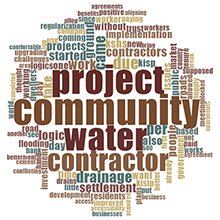Measurement of success
How to measure the success of basic infrastructure interventions

Can we call an increased number of sewer-connected households automatically a “success” of basic infrastructure interventions? It depends. Currently, there are different perspectives on how to assess the “success” or “performance” of basic infrastructure interventions. The SUSIS project under the WINGS programme is developing a framework that contributes to harmonizing such perspectives.
In the project, performance is measured from two dimensions: the supply (i.e. output) and the use of basic infrastructure (i.e. outcome). The former assesses whether the infrastructure is provided and performs properly. This is the commonly reported dimension. It assumes that once infrastructure is delivered, it will have cascading positive outcomes. Two examples of this are the number of kilometers of roads built and the number of households connected to sewers. The latter refers to the number of residents who could actually use the infrastructure, whether as expected by the providers or not. For instance, how many households connected to sewers continue using them after a given period of time? This can illustrate how well the providers anticipated challenges imposed by the context. Combining these two dimensions in one framework is useful to establish how a successful project really looks like and specifically for whom. Implementers of such projects ought to consider these two dimensions during the project design and within the overall project cycle. On the other hand, funders ought to combine output and outcome-based funding and monitoring, and to understand the dynamics and complexities associated with them.
Key insights
-) Measurement of project success should include both provider and user dimensions
-) Implementers and funders should integrate both dimensions in project design, funding and monitoring



